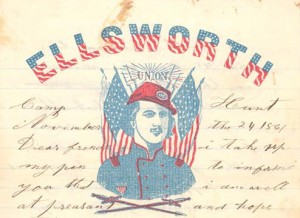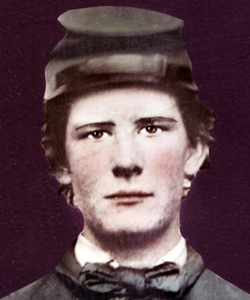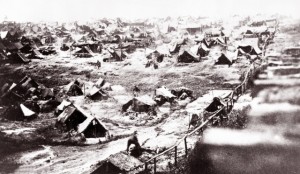Today, I spent time working in the archives, exploring the McClintock riots. Beginning with the John McClintock Collection Register, I examined information pertaining to years around 1847. I looked in John McClintock’s drop file under Miscellaneous Materials, Folder 6 Box 3 MC 1999.12(1). There I discovered the defense speech or closing speech for John McClintock given by William M. Biddle. Biddle was one of the three attorneys helping lead prosecutor, J. Ellis Bonham. I transcribed pages 1-3 below and read the rest of the 15 page speech for content on McClintock and the riots.
(Page 1)
W.M. Biddle, Esq rose and said-
May it please the court- Gentleman of the Jury-
In this case the defense differs from that which has been ______ for the other Defts. Some of choose who have proceeded me have gone upon the ground that no riot was committed or that if there was a violent skives in the streets it was justifiable under the laws of the land or that there was some excuse and +c and a vast deal of law has been reads and a great many casts cited on that subject. So far as Mr. McClintock is concerned he had nothing to do with it. Mr. McClintock case is like that of any gentleman in the jury______. If it was wrong, in was something to which he was not a party. There was no______ of his dove is which he was not perfectly justifiable under the laws which goverce us all. Therefore, Gentleman in this case, the observations made by others in Defts of the other Defts are not applicable to his defence (I mean where either attempt justified force or anything of that kind). It is not for me to remark situated as I am upon the defence for standing as a co-defendant it might have an injurious.
(Page 2)
Effect upon the cases of the other Defts. But I wish the Jury to bear district in mind whether they believed in the doctrine +c different Defts. It is a question of no moment to Mr. McClintock for we say he had nothing to do at all with any illegal proceedings. Gentleman, I _____ the case to you and I told you there has been scueues of a riotous nature going out form are early hour of that day. I told you earl as 8, 9, or 10 o’clock at the Justice’s office, there was a tumultuous assemblage around the jail and the people seemed to think there will be a riot. I told you that of all these transactions Mr. McClintock was profoundly ignorant and I told you that I would show you that +c not yet the intimations were so strong that gentleman left the courthouse knowing how the weather was to terminate. Did we prove this? Why, Gentleman this most indubitable. Law any man on earth disbelieve Mr. Sanderson? And does not his detail of what they took place carry conviction to the mind of very unprejudical man. He says that
(Page 3)
Professor Mr. McClintock, +c or his way here with letter and paper in his hand +c talking a diagonal; cut at the corner of the Square, he hailed Mr. McClintock. He first asked him if he was not going upstairs “What for?” said Mr. McClintock. There is a slave case +c.
William M. Biddle kept emphasizing that McClintock was “perfectly proper” throughout the speech. He focused on how McClintock did nothing wrong. I continued to read the closing statement, but it did not offer any insight or additional information that might be helpful to continuing exploration. However, it helped me get a feel for McClintock and the case that was presented.
My primary goal was to find out more about the individuals, besides John McClintock and Daniel Kauffman. Initially, I wanted to examine more information on Judge Samuel Hepburn during McClintock’s trial. Was he elected or was he appointed? Was he a state or county judge? I determined that he was a county judge, so my plan is to research at the Cumberland County Historical Society. I will be looking for records on the county judges and court records. I may not achieve any results, therefore I will have to look at other records in the Congress, where Hepburn ran for an office before this trial. In addition, I should explore family genealogy to see if that gives any insight on his life in Carlisle.
I found some information on Hepburn as well as other participants in these trials in Martha C. Slotten’s The McClintock Slave Riot of 1847 from Cumberland County Historical Society and Hamilton Library Association of Carlisle(2). Slotten’s is available at the Cumberland County Historical Society as well as online at Cumberland Civil War. In doing this, I discovered that Judge Samuel Hepburn was a Democrat who ran for Congress, but ended up narrowing losing to a Whig.
In addition, McClintock recorded many comments in his diary about Judge Hepburn and how he felt Hepburn influenced the trial(3). McClintock wrote to a friend in Connecticut:
“The conduct of our judge has been severaly in Pennsylvania as it could be in New England: the weightiest newspapers of both parties have spoken of his conduct in very much the same terms as those used in your letter. Several of them threaten him with impeachment, and some of the politicians of the state have preferred me their assistance in the case I undertake it.”
McClintock also said in that diary entry:
“The judge has but one more year to serve and will not be reappointed. He is a young man very ambitious of politics distinction, but of very narrow mind, limited education, and vulgar feelings. His hatred of the College is intense and he would do anything to break it down.”
I discovered that they generally selected judges based on their integrity and character in the community(4). In addition, the Carlisle bar was under the direction of Judge Reed, the President Judge of the District when Samuel Hepburn was a member of the bar.
I will continue to work on exploring Judge Hepburn, but I would like to find out more about the defendants of the case, James Kennedy and Howard Hollingsworth. This is one piece of information that seems to be lacking. The next starting point in the research I intend to pursue includes some pieces from newspapers. I will then follow leads from what I find in the context. The newspapers are as follows:(5)
Hagerstown Herald of Freedom
Philadelphia Public Ledger
Philadelphia Bulletin
American Volunteer
Richmond Enquirer
US Gazette
The Freedman
Carlisle Herald and Expositor
New York Commercial Adversities
Christian Repository
New York Daily Tribune
Manufacturer and Farmer’s Journal
National Anti-Slavery Standard
Hagerstown Torchlight
Additionally, I could look at the Sheriff and officer who arrested the slaves, Sheriff Jacob and Robert McCartney. This may not help, but could have some insight to the feelings surrounding the trials as well as people’s general opinion on slavery.
(1) Defense Speech for John McClintock by William M. Biddle, 1847, ( filed labeled Miscellaneous Materials), John McClintock Records, Box 3, Folder 3, MC 1999.12, Dickinson College Archives.
(2) Slotten, Martha C. “The McClintock Slave Riot of 1847”. Cumberland County Historical Society and Hamilton Library Association: Carlisle, Summer 2000, vol, 17, num 1, 31.
(3) John McClintock Diary, McClintock Papers, Emory University Special Collections, October 12, 1847.
(4) Conway, P Wing. A History of Cumberland County. (Philadelphia: James D. Scott, 1879), 157
(5) Slotten, Martha C. “The McClintock Slave Riot of 1847”. Cumberland County Historical Society and Hamilton Library Association: Carlisle, Summer 2000, vol, 17, num 1, 35.






